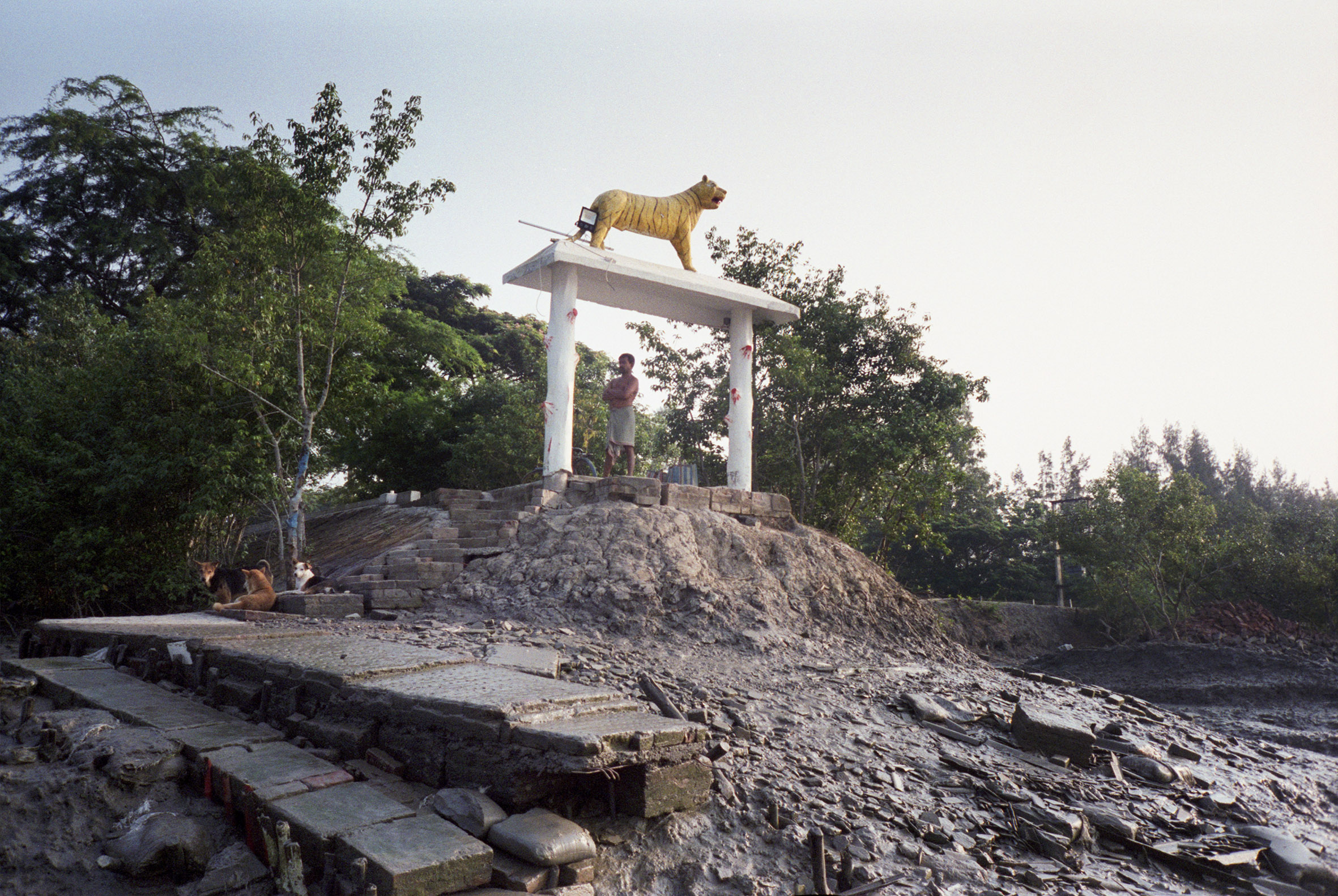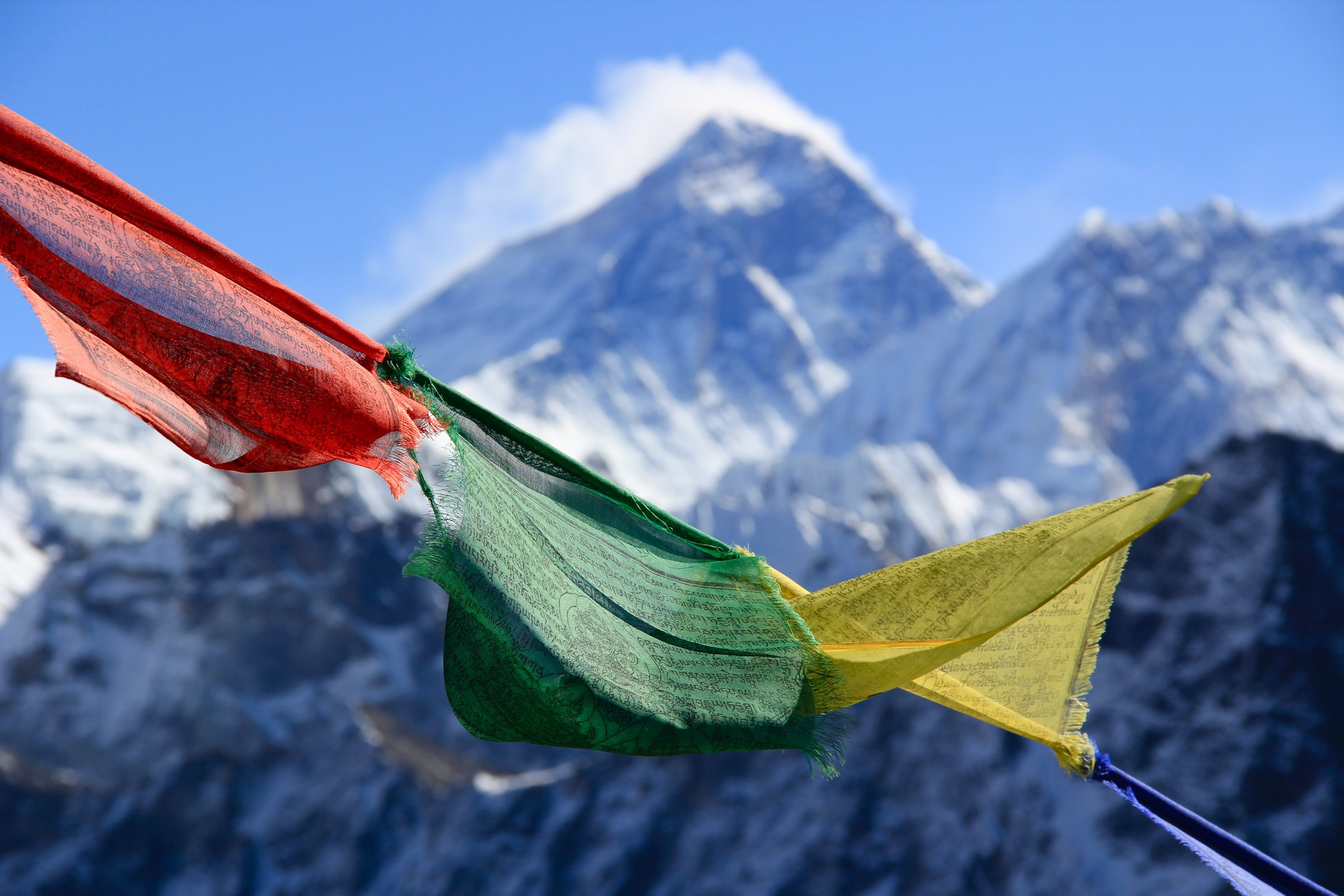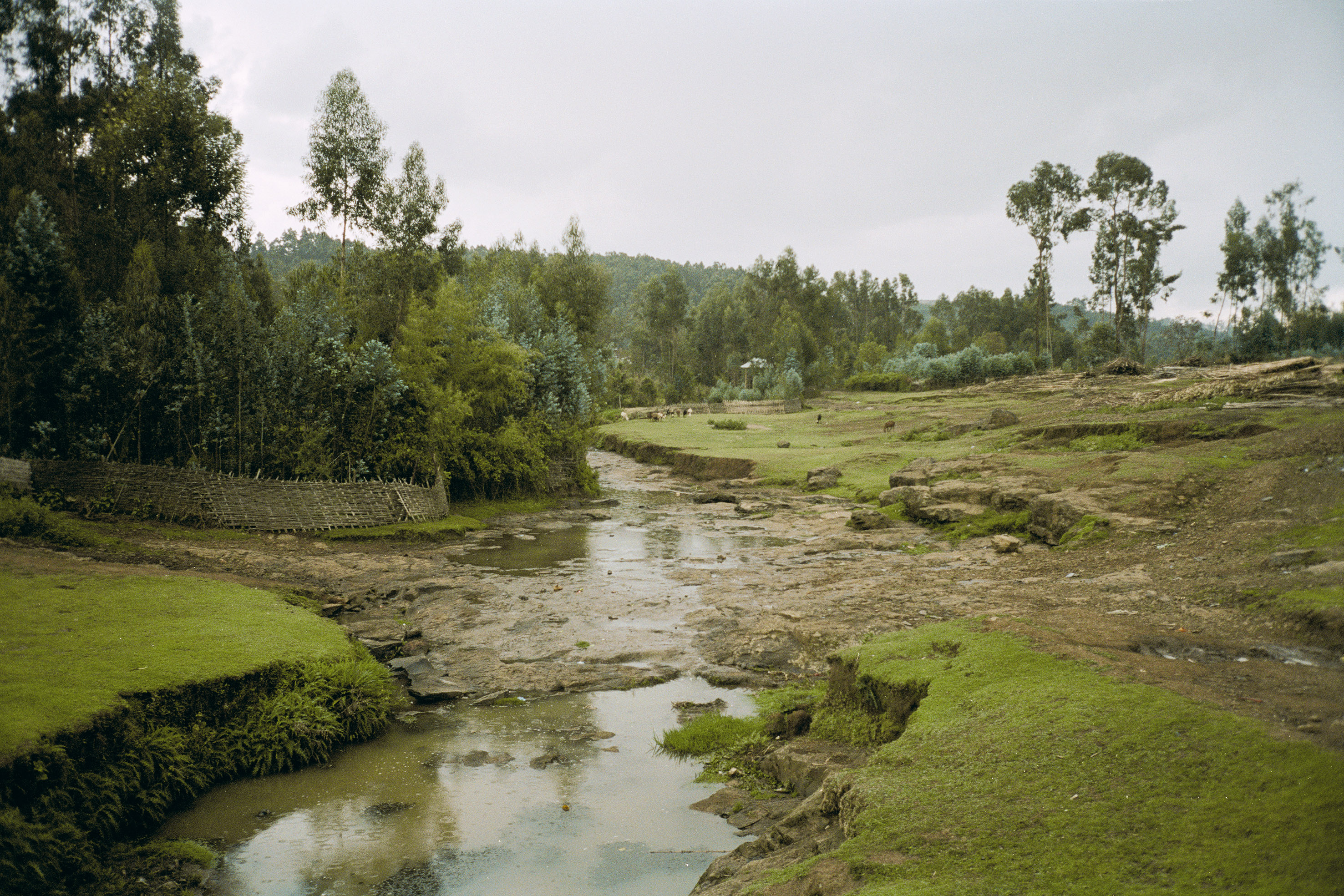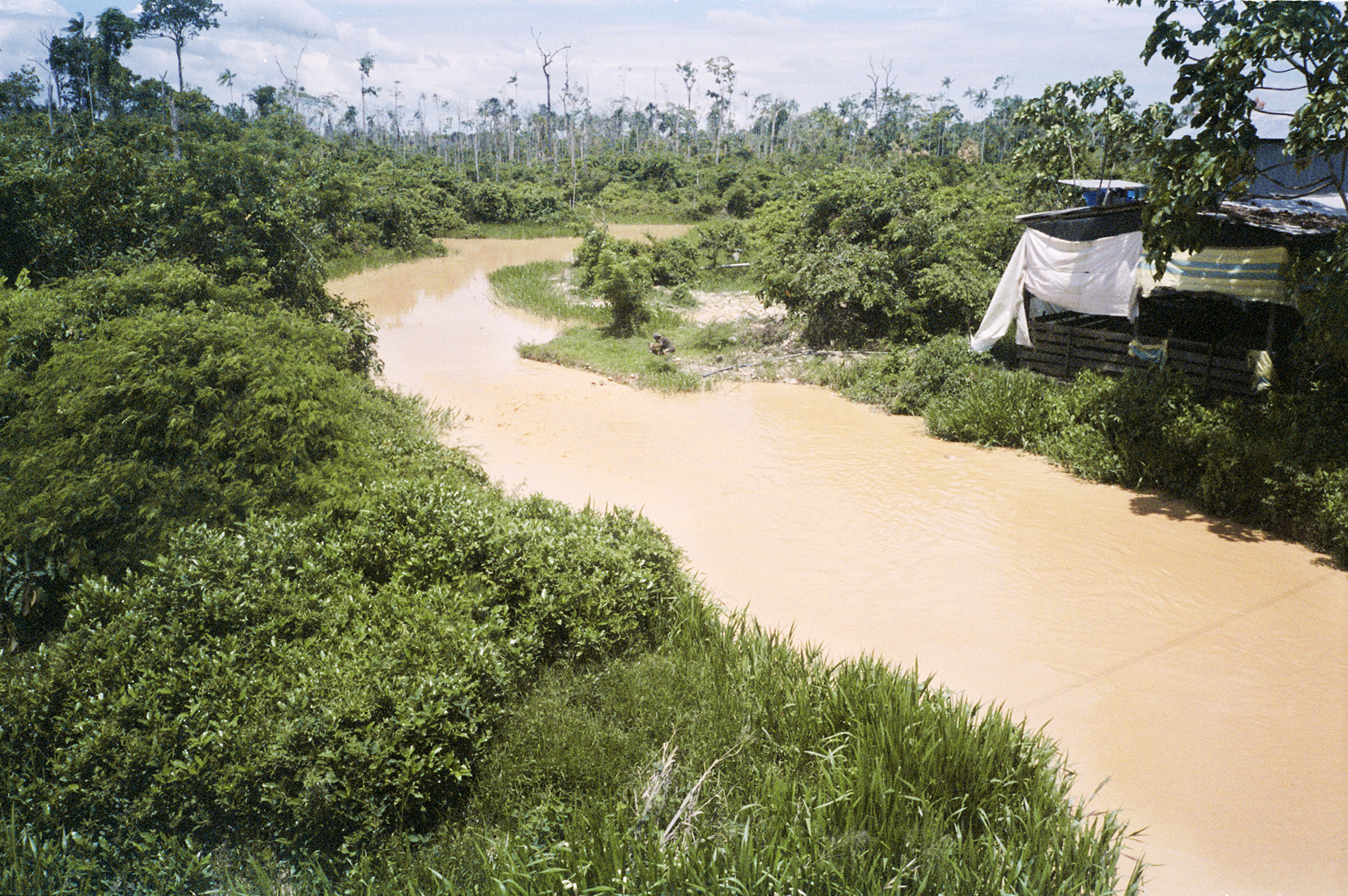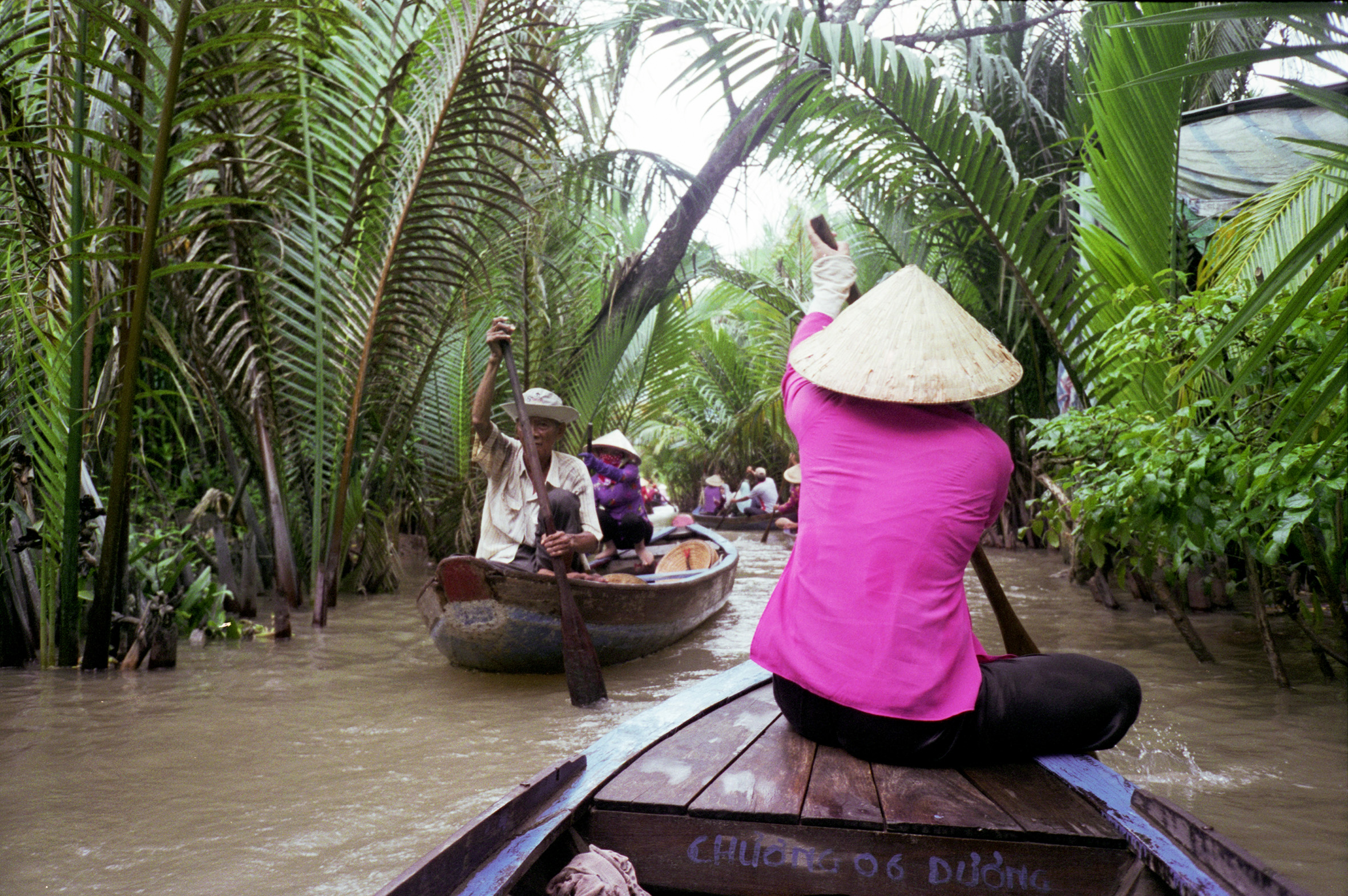
Between the fertile planes of Bengal and the waters of the Indian Ocean stretches an archipelago of green islands that disappear in the sea twice a day. Indians believe that only those pure of heart have a chance of surviving in the forest labyrinth of the Ganges Delta.
The darkness fades away an hour before sunrise. The sky turns pastel pink, quickly losing its hazy layer. The moisture hanging above the water will soon dissipate in the first wave of heat. The boats are sleeping, moored in the middle of the lake. At two minutes to six, a bright gold sphere peeks from under the thick wood. From now on, it all happens quickly. In just half an hour, the heat will be scorching.
From the huts deep in the island come the first sounds of life. The clanking of metal dishes, the splashing of people bathing in the ponds outside their homes, the cracking of wood in clay stoves. And the howl of conch shells, announcing the celebrations of the morning puja for the bloodthirsty goddess Kali, perseverant Vishnu, and Bonbibi, the goddess only worshipped in this region and the only deity in India recognized by both Hindus and Muslims. Bonbibi is the guardian of the forest, protecting her people from Dakshin Rai, a demon that presents himself as a man-eating tiger. The farmers pray to Bonbibi in little temples, recognizing her in every tree they pass, and in the earth they walk on. Those who live off the jungle – fishermen and beekeepers who take boats to the mangrove forest – touch the ground as soon as they reach the land, and perform a ritual expected to guarantee they come back safely. Bonbibi is the ruler of Sundarbans, an insular land by the estuary of the great Ganga River at the Bay of Bengal. The locals believe that cyclones and wild beasts obey Bonbibi’s every wish.
The salt of the earth
The calves moo, standing tied to lampposts and solar panels that the local government has installed in the village. The animals are waiting for green shoots and vegetable leftovers, soaking for them in plastic barrels. Around them, goats are roaming here and there, eating everything they can nibble on. Shiv Pada Tarafdar set the radio to full volume, as usual. He’s lonely and partly deaf, not much for him to do today. Still a month to go before the rice harvest season starts. And so he busies himself around the overgrown garden, wearing just a worn-out gamcha – a red-and-green checkered cotton strip tied around his hips. It’s the most modest of all clothing, which can also double as a towel or turban. Tarafdar’s knees are bothering him again. After 77 years of life filled with grubbing out trees, carrying bags of rice, shovelling dirt, and scooping out mud from the canals, his joints are ruined and degenerated, the same as for most people in rural Dayapur.
A blackened pot stands on a clay stove in the yard. It’s cold. Tarafdar has eaten nothing today. Since his wife left without a word five years ago to live in Kolkata with their older son, the man cooks for himself. It’s a shame to admit, but his children don’t try to stay in touch, so he won’t ask them for help. Years ago, he sold the family land to pay for their education. Now, to survive, he has to work in other people’s fields. He gets paid 250 rupees – three and a half dollars – for a full day’s work. His body is little more than a skeleton made of twisted bones. They press on his thin, darkened skin from the inside, as if trying to break free.
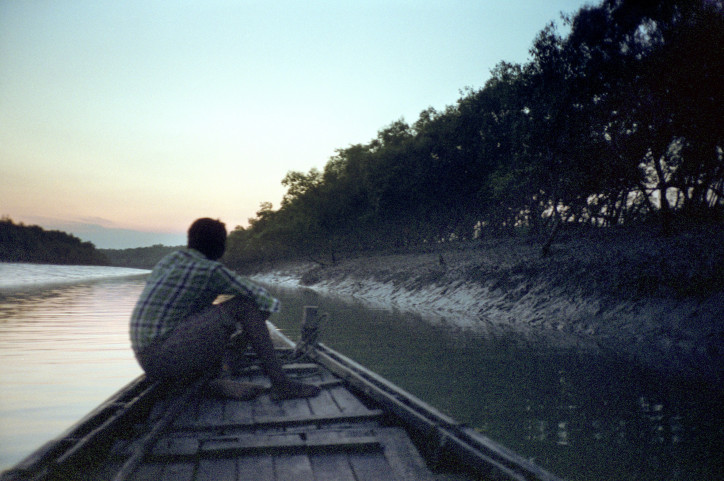
Three houses further, a seven-year-old boy runs into the yard, carrying a bottle of water on his head. He sets it down on a roofed dirt floor in front of the hut, next to other containers that are already filled. The boy ran here from the tap that stands on the path crossing – a few years back, they had drinking water pipes laid here all the way from Kolkata. It tastes salty, but it’s safe for drinking. And what’s more important is that it is here at all. Before it came, all there was to drink was rainwater and a few dodgy wells.
The patter of the boy’s feet did not scare the cat laying in front of the house, feeding three white kittens. Behind the boy, his grandmother follows slowly, carrying a bigger bottle. Her name is Gauri, surname Mandal, like most people in the village. She is delicately built and completely silver-haired. She is 68 years old, but her protruding ears and small, piercing eyes make her look like the girl that she probably never got a proper chance to be. She went to school for a few years, so she knows how to write down her name, but she forgot how to read. She married young and moved here from the neighbouring village to live in a hut made of bamboo, cow shit and mud, roofed with asbestine tile. The hut sits perched on a half-metre clay elevation that’s supposed to protect the home from cyclones. Not that it helps much – inside the hut, the wooden walls are still scarred with a dark grey crack – a memento left by the Aila cyclone from nine years ago. There was water up to the shoulders. It stood in the village like that for three weeks before it went back. Everything was ruined, most of all the land, cleared a hundred years ago with so much effort and then desalinated for a decade with monsoon rains. Before Aila, they harvested rice twice each season, now – just once. This year, the monsoon came a full month late, and it’s not raining much. The people of the village watch their sown-over fields anxiously.
Gauri’s grandson will help her to pick vegetables, and then he’ll go run with the other kids. He came here for his holidays; just a week ago, the Durga Puja festival came to an end, the Kali Puja festival is coming in just a few days, and then Diwali, the festival of lights and the goddess Lakshmi. The boy’s dad is a carpenter, and his uncle is a waiter. They both moved to Sonarpur – a suburban area of Kolkata; it is almost a town in its own right and an enclave for those who leave Sundarbans. Soon, they will take Gauri with them. They have already put the house and the farmyard up for sale.
Loneliness and poverty have been weighing on Gauri for 25 years now. That is, since the day she went to the shore to welcome the men coming back from a crab-fishing trip after a few days’ absence. The men told Gauri her husband was killed by a tiger. The animal dragged his body back to the jungle to eat it there. They added that her husband fought for a long time, holding the beast by its head. Gauri felt her legs give in, she fell into the mud. She can’t remember the several days that followed. She was left alone – a young mother of three, with no money. Sundarbans are full of young widows. Since yesterday, there are more of them in the village. Two 20-year-old fishermen never came back home from work. Not a week goes by without an attack.
After losing her husband, Gauri wanted to work, but there aren’t many jobs for women around here. Sometimes, she caught young shrimp, cut the rice, dug through someone’s field, made cow dung cakes for burning. By doing a few things at once, she can make up to five dollars a day. People prefer to hire men for fieldwork – they can carry more weight faster, make better money.
She was unable to feed herself and her children. She married her daughter off when the girl was just 13-years-old. She lowers her voice, knowing it’s both illegal and wrong. But the younger the bride, the smaller the dowry to equip her with. Her two sons left to work in the city as soon as they turned 13, too. Here, in Dayapur, all they could do was become fishermen, and she did not want that life for them.
Gauri managed to make ends meet until the day she was attacked by the village madman. He approached the woman from behind and hit her in the neck with a heavy object. The doctor said something was crushed or broken, and that there nothing could be done about it. For the past 15 years, Gauri has been living with constant pain, unable to work. She feels unwanted, a burden to her children. In the city, with her grandchildren, it will all be different. But now, she puts on a pot with milk on the clay stove. The boy is cradling a packet of biscuits in his hands, looking at his grandmother expectantly. The sun is already up, and they didn’t have their tea yet.
Dead water
Once the sun rises, the water goes down; the low tide in the morning reveals the island’s edges, glistening like fresh wounds, like an exposed strip of raw skin. From afar, they shimmer like silver; inviting, dreamy. But seen up close, they turn out to be frightening; they resemble a prediction of hunger and toil.
Here lies the Sundarbans’ earth, laid out along with the naked truth about its true nature: grey mud, thick clay. Slippery, cold, treacherous. It pulls you down to your knees and won’t let go. Soaked with sea salt, it’s useless for cultivation; only the most resistant plants can grow here. Now, in the morning, crabs are scuttling across its grey, bumpy surface. Yellow, blue and orange crustaceans flash their vivid colours that seem like a twisted joke: those creatures look like they’re trying to rebel against the ruthless, grim circumstances. Just like the bright-green sari of a woman standing ankle-deep in murky water, bent over a metal canister. In her right hand, she is holding a flat shell that doubles as a spoon. In the left, she is holding a plate filled with water poured from the canister. A few small flicks of her wrist help the shell pick out some tiny specks, which she then throws in a bucket. It’s a tedious, repetitive task, her movements certain, almost ritual in their steadiness.
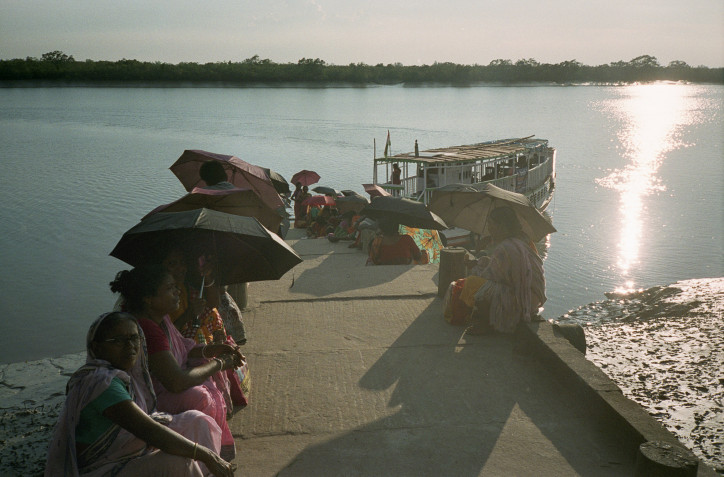
She came here before 4am, set down her tools on the shore. Then she threw a wooden-framed net onto the water; she’d attached thin strings to the frame’s corners. She gathered the strings and went neck-deep into the water, walking slowly, with effort, holding the straps tightly so that the net could flow behind her. She walked a kilometre to the east, then turned back by the concrete ghat – a haphazardly made pier, its stairs cascading into the water. Next, the woman returned to where she came from, just as slowly, so that she wouldn’t lose a single tiny creature.
For all that time, she was not safe. The rivers here are crawling with crocodiles and sharks. Crocodiles crush their prey, then drag it into deeper water and drown it. Sharks rarely go for a kill, but torn or ripped-off limbs are a death sentence in the village; the nearest hospital is three hours away. There are some widowers here, too. One of them – a 70-year-old man in a yellowed T-shirt and soaked gamcha – is now mooring his boat by the shore, accompanied by his young daughter-in-law. While he talks to me, the girl covers her hair with the sari, looks down, and silently shows me how little they managed to catch today: six tiger prawns and four small fish. Not enough to make dinner, not to mention making a sale.
The woman in a green sari is standing by her canister again. The net, made of two layers of thickly-woven nylon mosquito mesh, is tied at the end. She pulls the knot apart ever so delicately and puts the bit with her catch in the canister. The catch looks like two miserable handfuls of sludge, not much more. And again, from the beginning: pouring and catching tiny specks with her shell. An hour-and-a-half passes by – she keeps repeating the same few movements in the same position. Her hips pushed out, the small of her back curled, her legs digging firmly in the mud.
Those specks are young shrimp. Last time, she was paid 150 rupees – two dollars – for a thousand she sold to her neighbour, who has a farming pond. But today she won’t even make that much. The high tide waits for no one. The water is already rising, and she still has to make breakfast for her children. Others have it a bit easier. Women fishing on the other side of the ghat work together with their husbands. Double the labour, double the income.
The woman in the green sari pours out the rest of the water from her canister, then takes it under her arm, grabs the bucket, and props the net frame firmly against her hip. Bending down, she climbs up the shore, curling her toes like claws, digging them deep into the slippery goo. That’s the only thing keeping her from falling down.
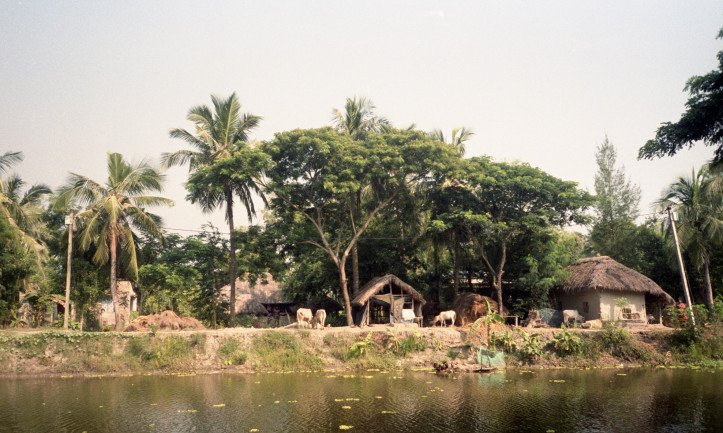
Her sudden bright smile – the corners of her mouth stretching almost up to her eyes – is an unexpected reward. A flash of light in the swathes of grey. Especially since the day started badly for her. She caught just 700 shrimp. They call it “dead water” – water that does not feed, does not help with survival. Time to go back home, to her ill daughter who, despite having gotten married last year, came back to live with her mother. The husband’s family doesn’t want to feed a girl who is unable to work. The woman’s son is still in school. And her husband? There is no husband. Nine years, maybe ten… Was he ill, too? No, bāgha – a tiger. Her eyes darken, the glow in her face goes out again. She turns her tired body, blackened from the sun, and walks back to the village.
Her last steps fall on the shallow mud that’s already drying, but she remains careful. Here, among the mangroves, sharp spikes hide in the ground, shooting up from the mud. They are tree roots, using the spikes to hold onto the earth with dozens of sharp hooks that are a nightmare for human feet and tiger paws alike – they can pierce the skin and make the hunting more difficult. The spikes stick out like the shore guardians; the messengers of bad news. Everyone who tries to come on land is warned about its dangers. But if not for those roots, with their extraordinary ability to breathe during high tides, when the trees are covered almost whole, there would be no forest here. Nor any other form of life.
Everything flows
The name Sundarbans has a double meaning in Bengali. Sundari is the name for the tallest tree growing in this region. The same word is used to describe a beautiful woman. It all makes sense – those unique trees and shrubs make for the exceptional character of the local beauty. Without them, only fear would float on the water surface. During the high tide, plants disappear – some only have their tops sticking out from the water, turquoise-and-brown hummingbirds rocking gently between them. For others, just the roots and trunks disappear under the water, creating an illusion of floating patches of green. The animals go and hide in the deepest part of the islands, where the ground is higher. They can all swim, but they need islands for hunting and finding food. All those animals have become used to saltwater. Tigers drink it, deer drink it, leopards and boars do, too. However, salt ruins their kidneys, liver and heart, making them live a few years shorter than their cousins who were lucky to be born in better environments. But the very fact that they have survived is impressive. They most likely came here from Myanmar up to 400 years ago. Rapidly-growing urban areas cut off their way back home, locking the animals in a double trap made by nature and humans.
Since 1947, Sundarbans are divided by the border between India and Bangladesh (formerly East Pakistan), but biologically, they are one organism. They are the largest mangrove forests in the world, their ecosystem thick with secrets and dangers. It is extremely dangerous to anything that tries to stay alive.
The islands stretch for 80 kilometres south from the city of Canning all the way to the waters of the Bay of Bengal. It was the waters moving back towards the land that created this moving area of salty marshes. But that’s not the end of the marvels here – the area is wrapped in the embrace of the sweet waters of the Ganges from both sides. They lie in-between the river’s two mighty arms: the Hugli from the west, Kolkata side, and the Padma in the east, Bangladesh side. Between them, the largest delta in the world formed, measuring 260 kilometres in width. The tangle of rivers, streams, bogs and patches of land take up over 140,000 hectares. No shape and no border here are final – this land is defined by its own, unknown-anywhere-else rhythm of high and low tides that make it all disappear under the water and emerge again, always a little different than it was before.
It owes its constant transformation to tides that come one after another four times every 24 hours. Every six hours, water goes up until it reaches its maximum height, after which it goes back again. The difference in water levels can go up to six metres. It’s easy to follow – all you have to do is look at tree trunks, white with salt, and their leafy crowns. High tides take place around midnight and noon; in the morning and before nightfall, water goes down. This rhythm is controlled by the moon, and the tide time moves by about 26 minutes every day. High and low tides are also different from day to day, being strongest during the new and full moon. During that time, fishermen can enjoy the abundant haul. But during the two weeks that come in between, the people have to make do with a more modest catch. There are less and less fish in the water. Back in the day, fishermen left smaller crabs and fish for reproduction, but today they bring home anything they can find. The water level in the oceans is rising; over the course of the past two decades, it has risen by half a metre here in Sundarbans. Another half-metre will be enough to drown the cities deep in the land.
Sundarbans are a world devoid of promise, steeped in uncertainty. Everything flows. Water goes together with the earth, muddy knots dancing under the surface. No river here is clear, and the murkier the water, the worse for the animals – they cannot see the fishing nets, and fall in them sooner.
There is no one map of Sundarbans; a new one is born every day. The water carries masses of mud with it, pulling clay off one shore just to bring it to a different one. Some islands disappear, others emerge and grow. And when some canals fill up with water, some dry up or are swallowed by rivers so enormous that they look like the sea. Plants and animals depend on the whims of much greater powers. For people, living here is also reduced to an effort to survive. The clay embankment built on the shores will not protect anyone from a cyclone – the wind and high waves will break through the dams and wash away the mud huts. Strong winds will carry the trees, livestock and boats. Saltwater will devour everything. And those who remain alive will start again, from square one. Like many times before.
Stupor
Six minutes before noon, the waters reach the highest point. Boats moored by the shore start bobbing on the surface. The heat is unbearable. At that time, boats that loom away on the rivers and canals look like ghosts; their crews hide under little bamboo roofs. The villagers seek some refuge on the porches, the rooms are too hot. Wild animals hide among the shrubs on the islands. Only a few hours from now, everyone will come out from this all-numbing slumber, soaked in sweat, stunned by the heat.
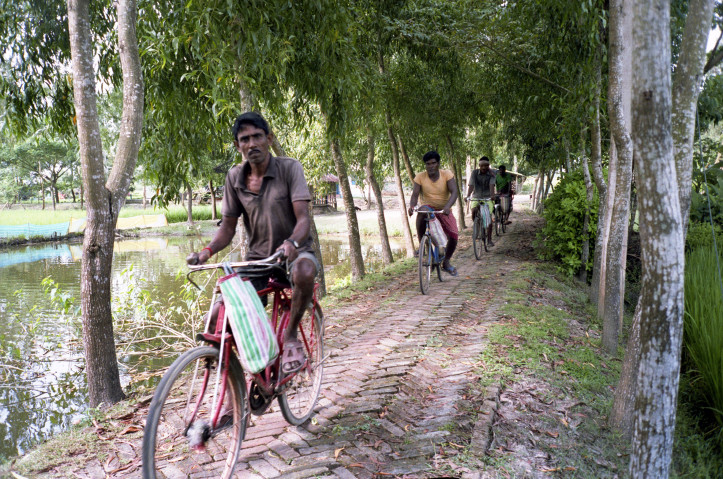
Local brahmin Toposh Ghoshal is cycling back from the morning service in his two temples: one of Durga, one of Vishnu. He rocks from side to side on his squeaky vehicle, spreading his knees, covered with a cotton dhoti. And yet, he’s quite fancy. His saffron shawl with batik pattern goes well with the light-yellow jacket. The man is 45 and has a lot of work to do. He sits on a little wall by the shore to pick up a phone that won’t stop ringing.
This time, it’s about an initiation ceremony for a sadhu, that is a man about to become a holy man. One of the men from the village will abandon the earthbound reality, including his home and family, to become a pilgrim, committed to the ascetic lifestyle and prayer. But in order to transform into a sadhu, the man needs a priest. During the season of religious festivals, the priests have to add plenty of home visits to their regular schedule of temple service. Those visits include pujas, conducted in family prayer rooms, and cremations, regardless of what time of the year it is. When the body cannot be cremated – because it was eaten by a wild beast – the family makes a symbolic figure out of leaves to be put in a fire as a substitute. The ceremony is held four days after the person’s death. Life swiftly comes back on track.
The brahmin sits down in half-lotus. In a pained voice, he comments that rushing time is the real demon. It devours everyone, including overworked parents who have no time to teach their children their own traditions and customs. Instead, young ones are given smartphones and TVs.
“Our temples are becoming deserted,” sighs the priest. “Only one in three young people comes over to pray. These children live on their delusions of fulfilment, sex and everything those movies and advertisements put into their heads. But that’s an imaginary world. It doesn’t exist,” he concludes, spitting out the last bit of paan that has tinted his tongue and teeth red. He says goodbye, skipping the customary formulas, and heads home to make a list of props, mantras and flowers he will need for tomorrow’s ceremony. Looks like even the brahmin suffers from a lack of time. Or perhaps he was just hungry. It’s lunchtime.
In the teacher’s house, hot silence hangs in the air. The daughter-in-law has just fed his grandson, and now the child is sleeping in a cradle hanging from a joist under the ceiling. Anjali Bikash Mondal, a retired maths teacher of 40 years’ experience in a village school, is sitting silently in an armchair. He watches his garden through thick-rimmed glasses, an indispensable symbol of the old Bengalese intellectuals. And the garden is very beautiful indeed – blossoming bushes three-metres tall, vegetable patches with pumpkins, pointed gourds, potatoes and cucumbers. Banana trees, agaves. One cannot even begin to imagine how many years’ worth of work and patience it took to have them grow like this. Mondal’s ancestors came here from Bangladesh on rowing boats, escaping the violence that erupted when the subcontinent was divided into India and two-part Pakistan (today’s Pakistan and Bangladesh). They grubbed out the mangrove forest with primitive tools. Every patch of land they managed to tear out from the jungle’s hands was then quickly surrounded by a muddy embankment to stop the salt water coming in. After that, one could only wait and hope for the rains to do their job – it would take 8–15 years for the water to wash out enough salt for the first seedlings to strike root. Until then, they were hungry. They ate seeds and wild spinach.
Mud, fieldwork, evenings spent by candlelight – that’s all the teacher remembers from his childhood. But he has something better than his own memories to show. In a little shed behind the house, he keeps about a dozen clay dishes: carafes and jugs. Dusty and wrapped in blankets of spiderwebs, they don’t look very impressive, but their delicate, fragile forms raise some questions. How old are they, actually?
“They come from the 10th, maybe 11th century,” explains the teacher, who wrote one of the very few works about the history of Sundarbans. He discovered these treasures before a nature sanctuary was created in the southern part of the island 50 years ago, meaning nobody was allowed to enter this area from then on. Mondal was walking around the islands by the very mouth of the Bay of Bengal when he came across some traces of human presence from mediaeval times. People used to live here long before man-eating tigers roamed those islands. The tigers eventually learned the rules of island-bound life and lived here, undisturbed, for three centuries. The next big wave of human migration took place around 1910, and was invented and encouraged by the British administrators, who wanted to revitalize this empty bit of land and create new, more justly-governed settlements for Indian people. That’s when the legend of a prosperous life in the salty marshes started to attract the poor and desperate.
The first to arrive were the members of Indian tribes, known as Adivasi, who are at the very bottom of the social ladder. In Adibashi Para, a tribe colony located several kilometres south from Dayapur, 57-year old Bashudev Sardar gives up on his afternoon nap. He goes out to dig his garden. Bashudev has to do it today; starting tomorrow, he will be building a drinking water reservoir for the animals in the sanctuary. He will go with 14 other men from his village, and they will be paid 3000 rupees ($40) between them for every cubic metre they dig. The work will take 10 days, maybe a bit longer than that. Bashudev needs the money to pay his debts. He fell prey to four pyramid schemes whose reps hunt down naive villagers, promising those illiterate people lofty profit. This way, Bashudev lost $700. On top of that, he still has a loan to pay for the TV set he bought because his wife and son kept asking for it. And there’s a patch of family land he pawned to pay for his daughter’s wedding. Now, he has to buy it back.
Bashudev’s family has very little other than debt. His son works odd jobs here and there. Any day now, he will leave with other young men from the village. They will go to Kerala on the opposite end of India; he has worked there before on a building site. The boy will be back in eight years’ time. Bashudev is hoping that this time, he will save more money instead of spending it all on clothes and a new phone. But his son is young and wants to have fun, so who knows what will become of the money-saving plan this time.
We talk in the shadow of large palm trees, in the garden behind the hut. A Bonbibi figure, made of clay and painted bright colours, watches us kindly from a small shrine by the pond. Bashudev crouches, wipes the sweat off his bald head with a piece of cotton cloth. He smiles a lot. Sometimes with embarrassment, but everything he says is laced with optimism.
“Compared to my grandfather and my father’s times, we have a good life,” he decides. A good life means not worrying whether there will be food on the table tomorrow. “We stock up on rice, onions, oil, potatoes. We eat rice with curry three times a day. And we are putting some money aside, too.”
After the scams, Bashudev opened a bank account. Now, he has not only debts but also some savings. What are his dreams for the future? A stone house. He just received funding to build a two-room house with an asbestine roof. What does he wish for his son? That he has his own water tank on the roof, which means running water in the bathroom.
The heat is not letting go. Bashudev’s two older brothers came over to catch some fish for dinner. They throw their round nets with lead sinkers into the water and pull them slowly, but no luck so far – all they pull out are heavy weeds. The shops in the village are all closed, heavy padlocks hanging on the doors. They will stay in place until 4pm when the heat eases down a bit.
Queuing for relief
The three-wheeled semitrailer rattles mercilessly on a bumpy cracked road to Dayapur, leading by farming ponds and temples. Everything is deserted. The violent sun has burned all colour out of the landscape; the world is bleached, waiting it out.
Only by the ghat, there is a crowd. Over 200 have gathered there, many of them the elderly and women with children. They all sit on the pier and the stairs leading down into the river, keeping some kind of visible order: to the left and to the right. They are waiting for something. And by the look of it, they have been waiting for a long time; the men are busy playing cards, women sit huddled in groups and chat. Near the road, three food stands have sprouted up. Vegetable pakoras and small fish sizzle in deep fryers, spicy samosas and milky tea are waiting. The closest to the water are four men, sitting on their heels. They came here first, at 4am.
“The doctor will be here soon. His boat already left the village next to ours,” says a man in a white cotton dhoti, leaning on a walking stick.
The boat comes once every two weeks, bringing two doctors: an old one and a young one, homeopaths delegated by an NGO. Over 200 people are queuing, and they say more will come. And yet, they are calm. The doctor takes no money and will see everyone. They know him and nod appreciatively. They believe he is helping them. With joint and bone pains, coughs, diarrhoea, headaches. Palpitations, high blood pressure. He can help with everything except the things that are incurable.
The doctor will be seeing patients on the boat. He does not examine anyone, just listens to the complaints and orders the medication to be prepared. It’s mostly solutions for drinking, a few drops at a time, or pills; rarely ointments. Everything is made by his assistants right there, on the boat.
There is a 21-year-old girl who came from Jamespur, for the first time seeing the doctor about herself. Before, she always came about her daughter, who suffered from a bad cough or stomachache. Now, she wants the doctor to take a look at the painful, stinging spots on her skin. They have been there since about the time she gave birth. Did she give birth in a hospital? No, it didn’t work out. Yes, she did call an ambulance once the contractions started (it is available for free to every pregnant woman), and took a ferry to Gosaba, but the doctors in the clinic there refused to deliver the baby because the woman’s blood pressure was too high. They sent her to the hospital in Canning. But as soon as the ambulance left the town, the girl gave birth – on her own, accompanied only by her frightened mother and aunt. There was no paramedic in the ambulance, just the driver. He left the mother and child in the nearest clinic. She spent a night there and went back home on her own.
After that, she had no health problem. Just this burning thing on her skin. She decided to see the doctor after a meeting with a paramedic from the village medical facility. Trained paramedics – people call them sisters – try to give women and their children some basic diagnosis and then send them to the pharmacy or advise that they should see a doctor. They cannot prescribe any medications, and they don’t examine the patients. They are the closest to what we know as community nurses here in Europe.
Sarat Mandal owns a pharmacy near the market in Dayapur. He says the sisters often send patients to him. The man stands behind the counter in his striped blue shirt, the fan turning sleepily above his head. In an open cupboard behind his back, boxes of medications sit stacked in some sort of order. The temperature is approaching 40°C, antibiotics and syrups are boiling in faded packaging. Painkillers are the most popular: paracetamol, diclofenac, ibuprofen. And drugs for food poisoning. Even strong injections are available over the counter. The pharmacist learned the trade from his father, he grew up surrounded by medications. He reads medical journals and attends professional training sessions organized by drug manufacturers. That means he’s constantly improving his knowledge.
While we talk, the heat slowly dissipates. Shopkeepers return, well-rested and with full bellies; dogs come out of their corners. Patients start coming in, too. They give the pharmacist pieces of paper with some notes. The pharmacist pulls his glasses down on the tip of his nose and then digs through one of the plastic boxes to find the right medicine. He cuts two, three pills out of the blister pack and hands them over to the patients, sometimes without payment.
“People have no money,” he explains.
“What about women?” I want to know. “Do they come here?”
“More often than they used to, but they’re embarrassed.” The pharmacist points at the curtain and a small room in the back. Over there, they can tell him what bothers them privately. It’s usually urinary tract infections and similar problems. He chooses meds for them. If there’s no improvement after three days, he sends them to the doctor. In Canning, because that’s the nearest clinic with a gynaecologist. Unless someone goes for a private visit, but that can cost thousands of rupees.
After 3pm, Sundarbans wake up and become beautiful once again – the second round of life will last until the evening. Bathed in golden sunlight, the trees emerge from underwater, their bright green leaves phosphorescent in the afternoon light. A small boat with an internal combustion engine coughs up clouds of black smoke, making a rhythmic sound: bhot, bhot, bhot… The locals call those boats “bhotbhoti”. We approach the shore because my guide has noticed something he wants to show me. In the place that, just an hour ago, was covered by water, there are the fresh prints of tiger paws.
“Male. Adult one,” he comments, shooting a look at the opposite bank of the canal. “He came from that direction.”
Over there, we can also see distinct prints on the ground. Right next to them, a long, deep mark left by a crocodile’s body. After the siesta forced by the heat, animals are back in the game. Birds and giant reptiles walk about on the exposed shores, deer are nibbling on the nearby trees and bushes. Everyone is hungry. How much life there must be hiding behind this mangrove thicket! Every tiny channel flowing into the greenery is like a riddle, a dangling secret tempting you to follow it and let the water pull you into the story. Even if it only brings you more of the same – more images of tangled greenery, holding onto the land with complicated root systems. The shrubs and trees also hold on to one another, living here in a natural alliance against the water that attempts to destroy them twice a day.
There is something confusing about the landscape of Sundarbans: monotony meets complexity, raw simplicity is laced with sophistication. The forest is hypnotizing. You could easily lose yourself in those channels, allowing the roots to twist around your mind and take you to secret spots that – once the water goes down again – turn out to be a trap. The view is changing from one minute to another. It takes years of living here in perfect synchronicity with the rhythm of the elements to really understand this place; to know where and when you should throw your nets, where to turn your boat around in time. The locals say that most people only meet a tiger once in their lifetime; the first time is usually the last. Bengal tigers weight 250 kilograms and are great swimmers. They can attack not just on land; those beasts know how to turn a boat upside down. Humans are easy prey, a slow one. The tigers go for the neck – to rip the spinal cord.
Darkness is coming, and so is the water
The sun is crawling back down. On the ghat, several dozen patients are still queuing to see the homeopath. Drugs are being administered. Name after name, one vial after another, plastic medicine boxes are emptying fast.
That’s just half of it. Among those waiting, I can still see the 21-year-old mother with a skin problem. She is hot, wiping the sweat off her brow and mouth with a small towel. The daughter is asking the woman to pick her up. They will have to queue for a few more hours, but they will not give up. Old men have already received their vials and pills. Leaning on their walking sticks and bamboo laathis, they walk towards the neighbouring village. They will be back in two weeks; the doctor gave them 15-day doses. At this time of day, the traffic in Dayapur leads only in one direction – to the market. Today, vendors of vegetables, fruit and meat come by in boats from nearby villages, and a vast dirt floor turns into a colourful carpet made of all kinds of goods. The market is crowded, noisy, spectacular. Everything is being cut, prepped and chopped on request, and then wrapped swiftly in newspapers and tied in bundles. Above all this hustle and bustle, the sky is painting dramatic pictures with orange and pink sweeps of colours, dotted with pristine white clouds of various shapes. Far away, we can hear the thunder, lightning bolts flashing in the distance. But today, the rain won’t reach us. And selling means living.
In a cul-de-sac, a small festival takes off. Children are setting off fireworks, activists speak from the stage. After dark, there is a conch-blowing competition. The best contestants are accompanied by howling dogs.
We leave with the last light of day. The crew of our worn-out but freshly tarred bhotibhoti – 30-year-old fisherman and two younger helpers – push the boat away from the shore with a long bamboo pole, starting the engine. The boat goes towards a small uninhabited island many birds choose for their resting spot. We pass by some tourist boats that rush to get rid of their passengers before nightfall so they can moor in the middle of the river. You can’t park by the shore – the boat could be trapped by a strong low tide, or there could be a tiger ready to attack. The omnipresent danger does not dampen the fear. The locals are afraid, but they say it is their land, their fate. Just like the animals, they have nowhere to go.
“We cannot all leave to Sonarpur,” says the carpenter. He’s built over 200 boats here. They took many fishermen to their untimely end.
“If I go to the jungle and bring some honey, I can make a year’s worth of living in just two weeks,” says Binoy Mandal, an almost 70-year-old beekeeper who survived a tiger attack 25 years ago. We are sitting in the shade of an acacia near Mandal’s crumbling hut. His almost-black skin is decorated with shiny jewellery: bracelets, a ring and colourful threads tied around his wrists. I put my hand in the empty space where his chest should be – the doctors cut out five ribs, gave him 72 stitches. The marks left by the tiger’s fangs are still clearly visible on Binoy’s back.
On that day, Binoy was on the boat. He saw a tiger getting ready to attack his friend, so he started yelling and leapt to the shore. The tiger charged at him and bit hard on his ribs, but Binoy poked its eye with his machete. The sudden flash of pain made the tiger jump away and sit down. For a moment, they looked at each other – both covered in blood. Then other fishermen ran to help them, and they scared the tiger away, shouting loudly. Binoy spent four months in the hospital. Afterwards, he went back to work in the forest. He often came across tigers, but they never attacked him again.
“The tiger is smart, it likes to watch you. But it doesn’t like to be watched. It won’t look you in the eye. If you want to survive, you must see the tiger first,” Binoy tells me. This morning, he saw four of them. They were swimming down the channel. A few weeks back, he came across a sleeping tiger in the forest. He walked to it from behind and scared the animal away with his shouts. He says Bonbibi protects him. Binoy always asks the goddess for her blessing before he takes his boat to the forest.
In the myth about this protective goddess, the earth was divided between the kingdom of the tiger demon and the woods that belonged to Bonbibi. In reality, Sundarbans consist of three zones: the one inhabited by people, the buffer strip of green where only beekeepers, fishermen and researchers with special permits are allowed to go, and the nature sanctuary closed to people and boats. Such division is supposed to protect both animals and people, but geography and instincts cannot be cheated. Tigers are hungry, and those tiny islands covered with thick greenery are not hunting-friendly. And so they eat whatever they can find, even crabs and fish. They come to the villages to steal some goats or calves; sometimes they visit when they get lost. Most deadly incidents take place on the tigers’ turf, visited by fishermen and beekeepers. Should the tiger attack, they are helpless. Hurting or killing the tiger means 12 years of prison. Since the 1970s, this animal has been under strict protection. In the past few years, its population was somewhat restored, but only thanks to ruthless regulations. According to last years’ calculations, supported by camera evidence, there are 88 male and female tigers living in the Indian part of Sundarbans. Every year, they kill about 50 people.
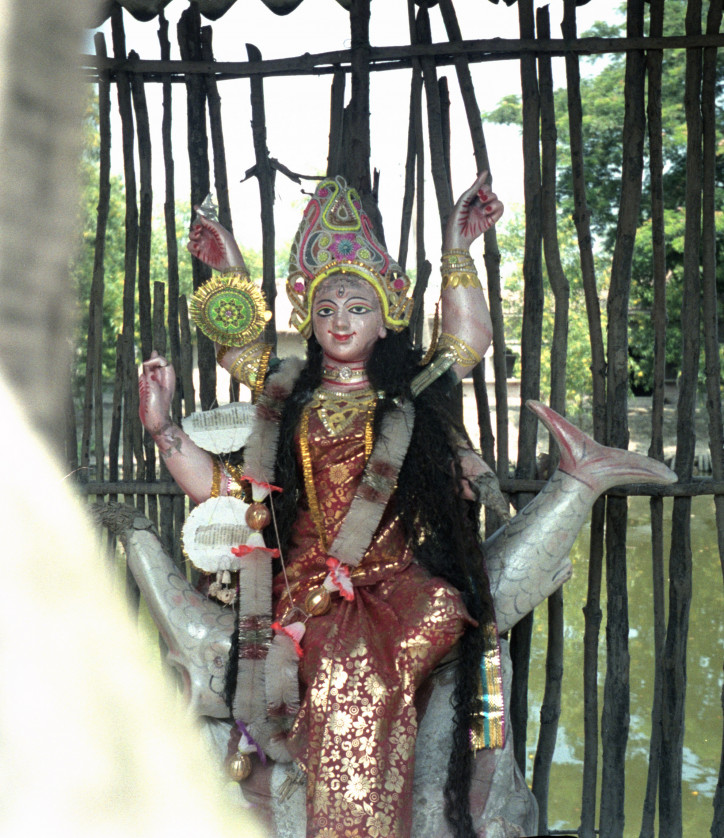
The engine is dead now, and our boat slides soundlessly in the channel. The boy with the bamboo pole is navigating at the helm, controlling the water level on both sides of the boat. On shallow waters, he has to use all his modest weights to negotiate a few more metres.
Darkness falls quickly. The water is black as tar, the sky turned purple. We cannot see the birds, but they are easy to hear – it sounds like they all flew down here to sit on trees and sing. The last concert of the day, the last speck of beauty before everything drowns in pitch-darkness. Life goes silent and still, animals sleep tied solidly to their barns, all doors and windows closed in every home.
We slide back to the village, cutting through the darkness. Above us, there is the Milky Way and some stars I do not know. Three boyish black silhouettes sit huddled on the helm. In the dark moonlight, they seem flat, one-dimensional. We can hear an ambulance in the distance – this night, another life will enter the world. But will everyone else manage to keep theirs until morning? The water is rising again, the forest demons are coming out.
Translated from the Polish by Aga Zano


